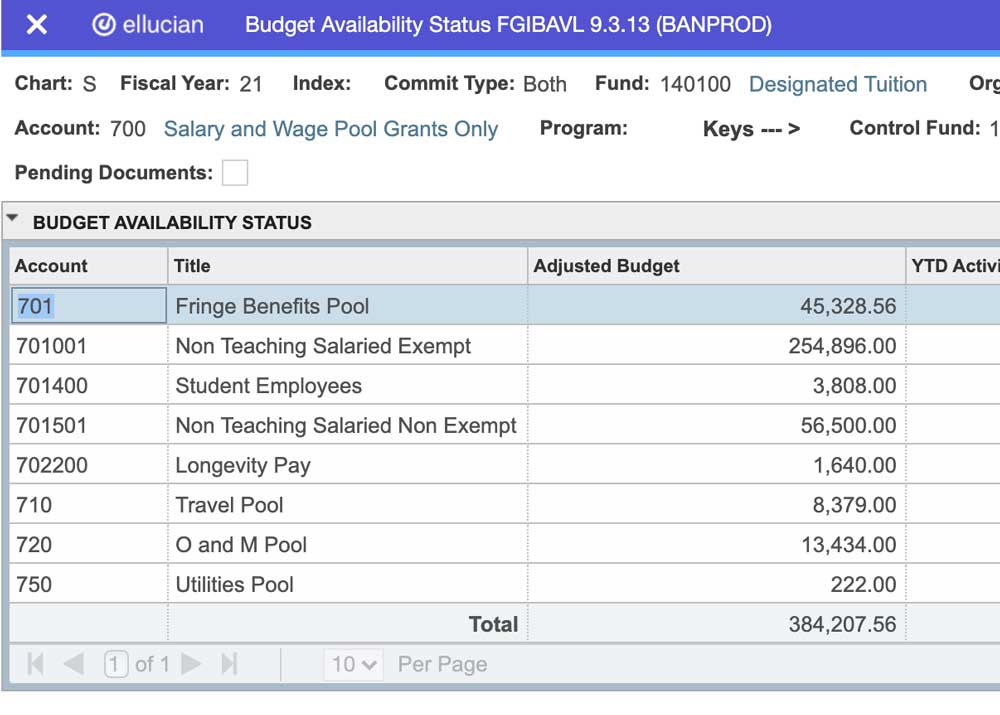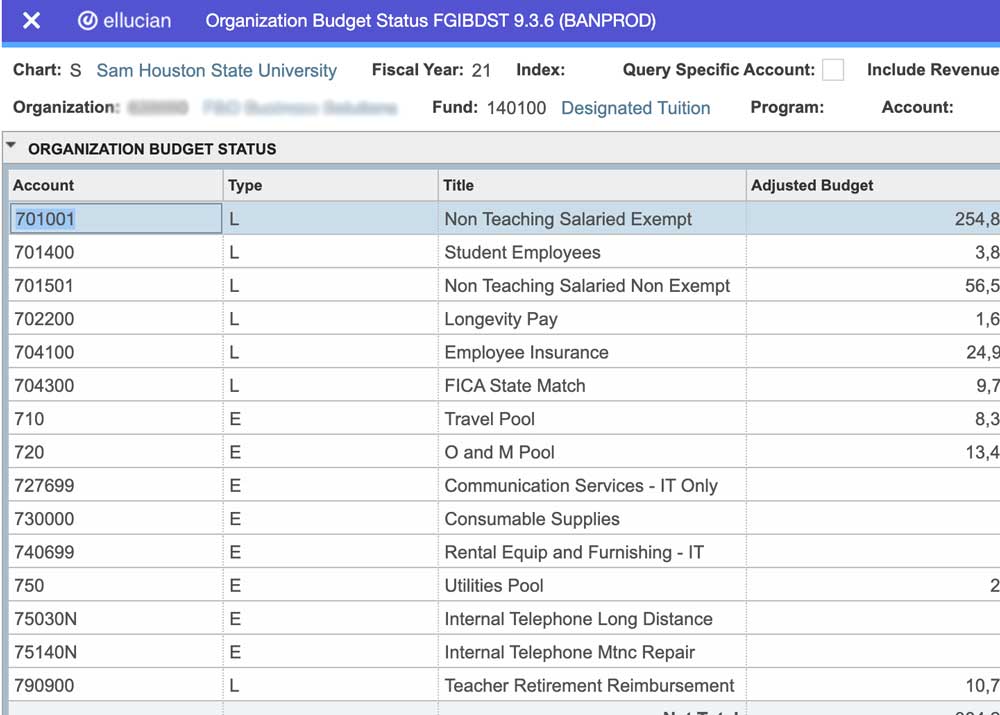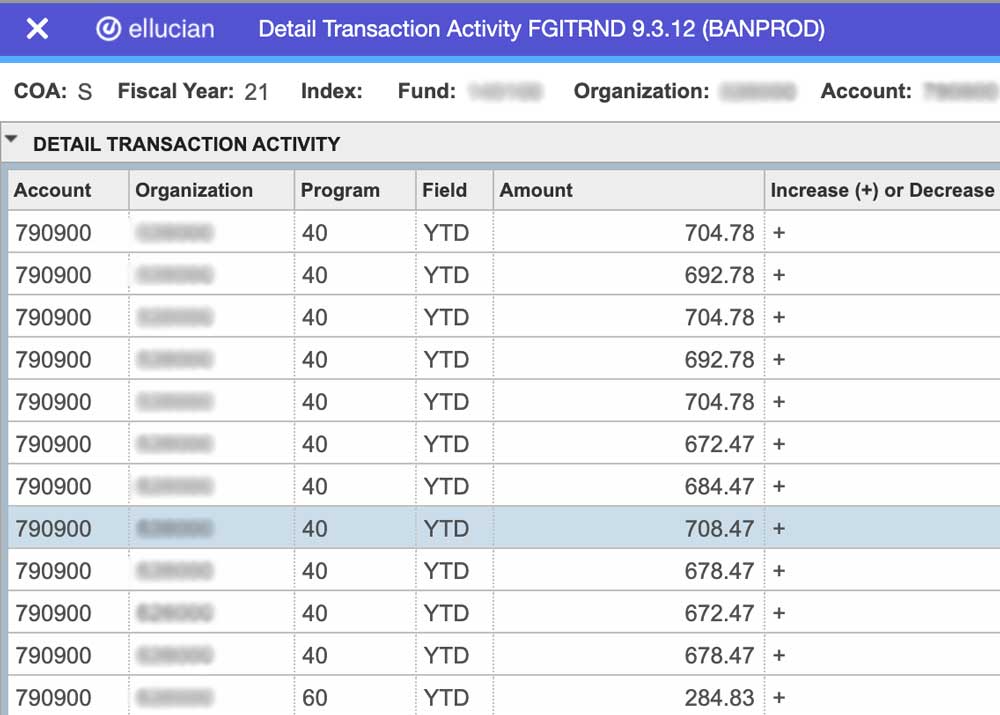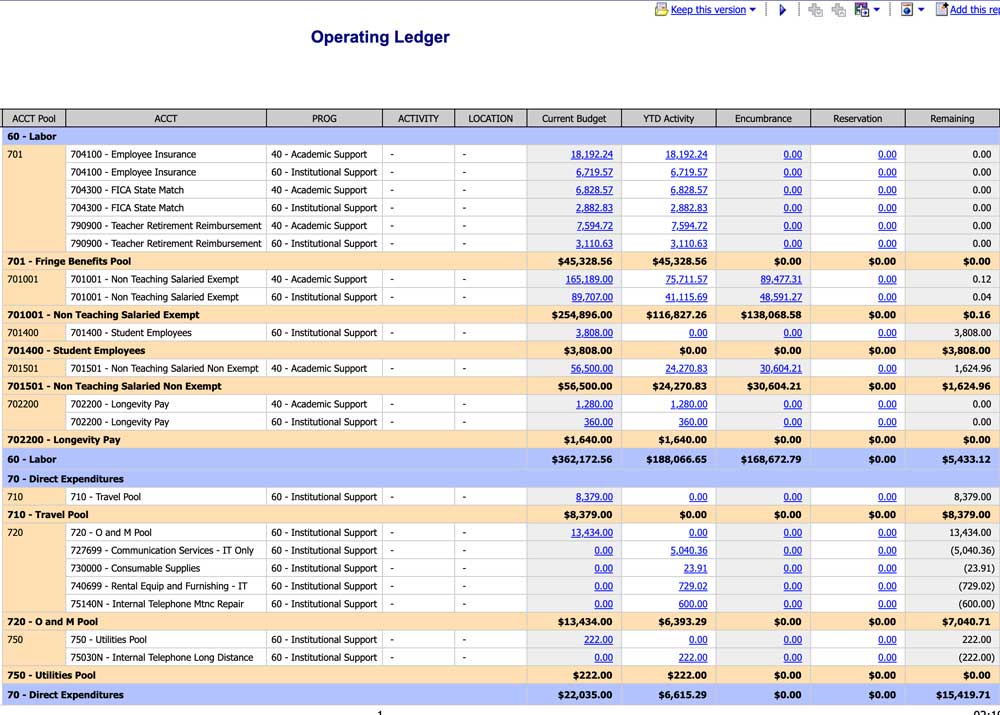Balances
An account balance represents the current value of a particular financial account.
Determine Your Available Balance
Your available balance is the total amount of money in your account that can be used for allowable expenses. Use one or more of the following screens to determine your available balance.

Budget Availability Status (FGIBAVL)
The Budget Availability Status screen, known as FGIBAVL, is available in Banner. This screen is enables you to view an online query of the budget availability for a selected fund, organization, and account combination. When in doubt on account code, use 700.
This screen will not show revenue balances.
Screen Terms
| Column Name | Purpose |
|---|---|
| Adjusted Budget | Original budget allocated at the beginning of the fiscal year plus/minus any budget adjustments throughout the fiscal year. |
| YTD Activity | Actual expenditures used throughout the fiscal year. |
| Commitments | Amount held for pending expenditures. |
| Available Balance | Adjusted budget minus YTD Activity and commitments. This amount is ready to use for allowable expenses. |

Organization Budget Status (FGIBDST)
The Organization Budget Status screen, known as FGIBDST, is available in Banner. This screen will show the selected organization’s budget, actual activity, encumbrances, available balances and revenue.
Screen Terms
| Column Name | Purpose |
|---|---|
| Account | 3 digit & 6 digit codes to identify accounts and budget pools. 6 digit codes identify accounts, while 3 digit codes identify allocated budget pools. |
| Type | Indicates the expenditure types. R stands for revenue, L stands for labor, and E stands for operating expenses. |
| Title | Name of the account or budget pool identified in the account column. |
| Adjusted Budget | Original budget allocated at the beginning of the fiscal year plus/minus any budget adjustments throughout the fiscal year. |
| YTD Activity | Actual expenditures used throughout the fiscal year. |
| Commitments | Amount held for pending expenditures. |
| Available Balance | Adjusted budget minus YTD Activity and commitments. FGIBDST looks at each expenditure individually to get an overall available balance by the budget pool refer to FGIBAVL. |

Detail Transaction Activity (FGITRND)
The Detail Transaction Activity screen, known as FGITRND, is available in Banner. This screen will show the transactions details for each budget pool and account code.
Screen Terms
| Column Name | Purpose | ||||||||||||||||
|---|---|---|---|---|---|---|---|---|---|---|---|---|---|---|---|---|---|
| Amount | Monetary value involved in the transaction. | ||||||||||||||||
| Increase or Decrease | Indicates whether money was added (+) or spent (-). | ||||||||||||||||
| Type | Rule code assigned to the transaction line.
|
||||||||||||||||
| Document | Assigned document number. | ||||||||||||||||
| Transaction Date | The date of financial activity used to determine posting period. | ||||||||||||||||
| Activity Date | The date the transaction was entered | ||||||||||||||||
| Description | Transaction descriptor assigned when the document was created. | ||||||||||||||||
| Commitment Type | Committed refers to encumbrances and budget that rolled forward from a previous fiscal year to the current fiscal year. Uncommitted refers to current fiscal expenditures and budget. |
For more information, see the Controller's Office.

Operating Ledger
Operating Ledgers are available in COGNOS. This report will show allocated budget, transaction activity, encumbrances and available budget.
This report does not update in real time. Transactions are posted the next day.
Screen Terms
| Column Name | Purpose |
|---|---|
| ACCT Pool | Indicates budget pool code, budget pool name, and account codes. |
| ACCT | Account name. |
| PROG | Program code and name. |
| Activity | Indicates whether funds were credited (added) or debited (spent). |
| Current Budget | Amount allocated at the beginning of the period or upon revision. |
| YTD Activity | Actual expenditures used throughout the fiscal year. |
| Encumbrances | Amount held for pending expenditures. |
| Reservations | Amount held for pending travel expenditures. |
| Remaining | Amount ready to use for allowable expenses. |
What's a Fund Balance?
Fund Balance is the cumulative net income or loss generated by the operation of the fund since its inception. Fund balance may be used for one‐time expenditures such as capital and faculty startup. Budget of fund balance is allowed by department on Other Designated, Auxiliary and Fiscal Year Restricted Funds. Contact your budget director if interested in the amount and usage of your fund balance.
What Happens to Remaining Balances?
At the end of each fiscal year, remaining balances for state, designated and auxiliary fund types roll to the fund balance that is then managed by the fund manager. Remaining balances for restricted, endowment and agency fund types roll to the next fiscal year and are fully budgeted. Fund balances can be utilized for one-time purchases with the consent of the fund manager and the Financial Planning and Budget Office with a Change of Budget. All fund balance adjustments are reported to the TSUS board for approvals.
Correct a Negative Balance
Negative balances occur when the expenses for the account are higher than the allocated budget. To correct deficit accounts, financial managers must submit a budget transfer or change of budget request. Budget Director will notify colleges and divisions when accounts are deficit.
